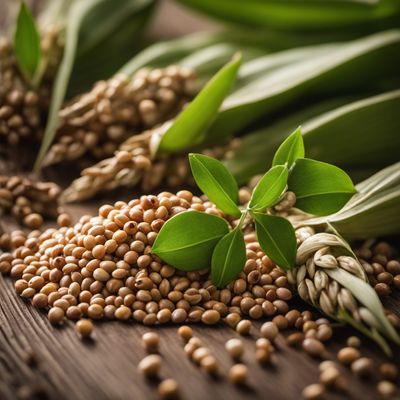
Ingredient
Sorghum grain
The Ancient Grain: Sorghum's Nutritional Powerhouse and Culinary Versatility
Sorghum grain is characterized by its small, round shape and pale yellow or white color. It has a chewy texture and a mild, nutty flavor that pairs well with a variety of ingredients. This gluten-free grain can be cooked and used as a substitute for rice, added to salads, or ground into flour for baking purposes.
Origins and history
Sorghum has been cultivated for thousands of years and has deep roots in African and Asian cultures. It is a staple food in many regions, providing sustenance and nourishment to communities. Sorghum's resilience and adaptability have made it an essential crop in arid and drought-prone areas.
Nutritional information
Sorghum grain is a nutrient-dense ingredient, rich in fiber, protein, and antioxidants. It is also a good source of vitamins and minerals, including iron, magnesium, and phosphorus. Additionally, sorghum is gluten-free, making it suitable for individuals with gluten sensitivities or celiac disease.
Allergens
There are no known allergens associated with sorghum grain.
How to select
When selecting sorghum grain, look for whole grains that are free from moisture or signs of insect damage. Opt for organic or non-GMO varieties whenever possible to ensure the highest quality.
Storage recommendations
To maintain the freshness of sorghum grain, store it in an airtight container in a cool, dry place. Avoid exposure to moisture or heat, as it can cause the grain to spoil or lose its quality.
How to produce
Sorghum can be grown in a variety of climates, but it thrives in warm and tropical regions. It requires well-drained soil and regular watering. Sow the seeds directly in the ground or in containers, ensuring they receive ample sunlight.
Preparation tips
To cook sorghum grain, rinse it thoroughly and soak it overnight to reduce cooking time. Drain the soaked grains and add them to a pot with water or broth. Simmer for approximately 45-60 minutes until the grains are tender but still chewy. Use cooked sorghum grain as a base for salads, stir-fries, or as a side dish.
Substitutions
Quinoa can be used as a substitute for sorghum grain, offering a similar texture and nutritional profile. Millet, with its mild flavor and delicate texture, can also be used as a substitute in certain recipes.
Culinary uses
Sorghum grain can be used in a variety of culinary applications, including as a base for grain bowls, added to soups and stews, or ground into flour for baking bread, muffins, and cookies. It is a popular ingredient in African, Indian, and Middle Eastern cuisines.
Availability
Sorghum grain is commonly available in grocery stores, health food stores, and specialty markets worldwide.
